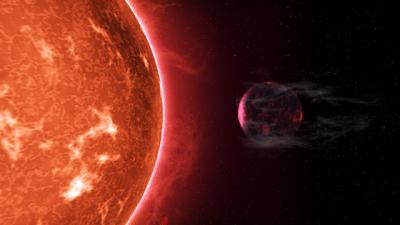Hot super-Earths stripped by host stars: 'Cooked' planets shrink due to radiation

This image shows a planet being stripped by host star's heat. Credit: Peter Devine
According to the study, planets with gaseous atmospheres that lie very close to their host stars are bombarded by a torrent of high-energy radiation. Due to their proximity to the star, the heat that the planets suffer means that their 'envelopes' have been blown away by intense radiation. This violent 'stripping' occurs in planets that are made up of a rocky core with a gaseous outer layer.
The scientists used asteroseismology to characterize the stars and their planets to levels of accuracy not achieved before for these systems. Asteroseismology uses the natural resonances of stars to reveal their properties and inner structures.
The results of the study have important implications for understanding how stellar systems, like our own solar system, and their planets, evolve over time and the crucial role played by the host star.
Dr Guy Davies, from the University of Birmingham's School of Physics and Astronomy, said: 'For these planets it is like standing next to a hairdryer turned up to its hottest setting. There has been much theoretical speculation that such planets might be stripped of their atmospheres. We now have the observational evidence to confirm this, which removes any lingering doubts over the theory.'
Dr Davies added: 'Our results show that planets of a certain size that lie close to their stars are likely to have been much larger at the beginning of their lives. Those planets will have looked very different.'
Scientists expect to discover and characterize many more of these 'stripped systems' using a new generation of satellites, including the NASA TESS Mission which will be launched next year.
Media Contact
All latest news from the category: Physics and Astronomy
This area deals with the fundamental laws and building blocks of nature and how they interact, the properties and the behavior of matter, and research into space and time and their structures.
innovations-report provides in-depth reports and articles on subjects such as astrophysics, laser technologies, nuclear, quantum, particle and solid-state physics, nanotechnologies, planetary research and findings (Mars, Venus) and developments related to the Hubble Telescope.
Newest articles

Superradiant atoms could push the boundaries of how precisely time can be measured
Superradiant atoms can help us measure time more precisely than ever. In a new study, researchers from the University of Copenhagen present a new method for measuring the time interval,…

Ion thermoelectric conversion devices for near room temperature
The electrode sheet of the thermoelectric device consists of ionic hydrogel, which is sandwiched between the electrodes to form, and the Prussian blue on the electrode undergoes a redox reaction…

Zap Energy achieves 37-million-degree temperatures in a compact device
New publication reports record electron temperatures for a small-scale, sheared-flow-stabilized Z-pinch fusion device. In the nine decades since humans first produced fusion reactions, only a few fusion technologies have demonstrated…





















